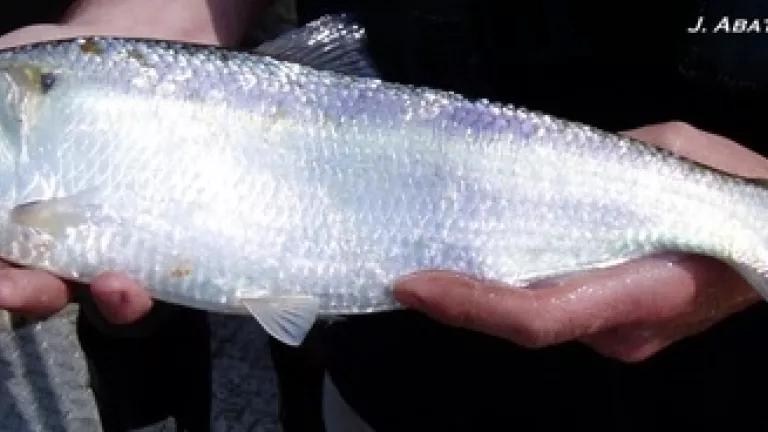NRDC, Fishermen and Watershed Protection Groups Launch Legal Action to Protect Disappearing Blueback Herring

Today, NRDC submitted a 60-day notice of intent to file suit against the National Marine Fisheries Service (NMFS) and National Oceanic and Atmospheric Administration, challenging the federal government decision not to provide Endangered Species Act protection for the blueback herring, historically an important forage fish in Atlantic coastal ecosystems but now decimated by fishing, habitat destruction, and pollution. The notice letter was submitted together with the recreational fishermen’s group Anglers Conservation Network, the Delaware River Shad Fishermen’s Association, and the New Jersey-based Great Egg Harbor River Council and Great Egg Harbor Watershed Association Trustees.
Blueback herring and the closely-related and similar-looking alewife are known collectively as “river herring.” River herring once made one of the great migrations on our continent, as I wrote about in a previous post. The movement of enormous schools of silvery, foot-long herring as they left the Atlantic to swim up rivers and streams in spawning season was an astonishing annual event. A vital part of healthy watersheds and coastal ecosystems, these schools fed predators hungry after a long winter, including striped and largemouth bass, ospreys, bald eagles, herons, harbor seals and river otters. Native Americans and European settlers also harvested the bounty.
Today, what was a vital part of both our Atlantic coastal ecosystems and cultural heritage has nearly disappeared. A fishery that dates back at least 350 years has declined almost 99 percent over just the last fifty. Up and down the coast, rivers that once had runs of tens or hundreds of thousands of river herring now have small remnant runs, if they exist at all. Causes of this population collapse include overfishing, “incidental” catch in certain ocean fisheries (e.g., Atlantic herring and mackerel), habitat degradation and barriers to spawning areas (e.g., dams), pollution, and climate change.
That’s why, in August 2011, NRDC submitted a petition requesting ESA listing for the blueback herring and the alewife. Our petition asked that each species as a whole be listed as “threatened,” because they are each likely to become in danger of extinction within the foreseeable future throughout all or a significant portion of its range, or, in the alternative, that Distinct Population Segments (DPSs) be designated and each listed as threatened species. In November 2011, NMFS published a 90-day finding that the petition presented substantial scientific information in support of the requested listings.
On August 12, 2013, however, approximately two years after we submitted that petition, NMFS, while acknowledging the river herring’s dire circumstances, issued its determination that listing either species was not warranted. We propose to challenge NMFS’s negative listing determination for blueback herring as arbitrary and capricious; we will let the government’s decision not to list alewife stand for now. Of the two river herring species, blueback herring has been particularly hard-hit, with its numbers in many rivers dropping significantly in just the last decade. Even as it declined to protect the blueback herring, the government acknowledged that the species was likely at or less than two percent of its historical baseline and that three out of four regional blueback herring populations in the U.S. were likely still decreasing.
Without protections, we believe that the overwhelming weight of scientific evidence shows that the blueback herring is likely to become endangered in all or at least a significant portion of its range—an unacceptable loss of part of our Atlantic coastal ecosystems and cultural heritage. We believe that the federal protection of a “threatened” listing would be a crucial and necessary step toward rebuilding this troubled species, and helping to ensure that the river herring migration continues for centuries to come.
NRDC and the other four groups have 60 days after the filing of their intent to sue before they are able to bring suit against NMFS in federal court. Earthjustice is representing the other groups in the legal challenge.

